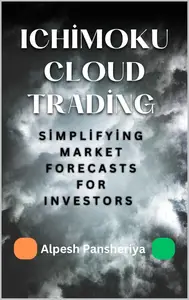Ichimoku Cloud Trading: Simplifying Market Forecasts for Investors by Alpesh Pansheriya
English | September 23, 2024 | ISBN: N/A | ASIN: B0DHV47VQ2 | 65 pages | EPUB | 0.85 Mb
English | September 23, 2024 | ISBN: N/A | ASIN: B0DHV47VQ2 | 65 pages | EPUB | 0.85 Mb
Understanding Cloud Behavior
The Ichimoku Cloud, or Kumo, is a vital component of the Ichimoku system. It not only serves as a dynamic support and resistance zone but also offers insight into the strength of trends and potential reversals. Understanding how to interpret the shape, size, and behavior of the cloud can give traders a significant advantage in anticipating future market movements.
• Interpreting Cloud Shape and Size for Trend Strength
The shape and size of the cloud offer clues about the market’s future direction and the strength of the current trend.
- Wide Cloud:
- A large, wide cloud suggests that there is strong momentum in the market. The more extended the cloud, the stronger the trend, whether it is bullish or bearish.
- Bullish Market: When the cloud is wide and prices are above it, it indicates that buyers are in control, and the market has strong bullish momentum.
- Bearish Market: If the cloud is wide and prices are below it, this signifies strong downward pressure, and the market is in a strong bearish trend.
- Narrow Cloud:
- A narrow or thin cloud suggests weak momentum and a lack of conviction in the market. When the cloud narrows, it can signal a potential trend reversal or a period of consolidation.
- Bullish to Bearish Shift: If a wide cloud starts to narrow, it might indicate that the bullish trend is losing steam, and a bearish trend could be forming.
- Bearish to Bullish Shift: Similarly, if a narrow bearish cloud starts to widen, it can signal the beginning of a stronger bullish trend.
• Flat vs. Sloping Clouds: What They Tell About Momentum
The direction or slope of the cloud plays a crucial role in identifying market momentum.
- Sloping Cloud:
- A sloping cloud (either up or down) indicates that the market has clear momentum.
- Upward Sloping Cloud: When the cloud is sloping upward, it signals strong bullish momentum and increasing prices. This is often seen during a strong uptrend.
- Downward Sloping Cloud: A cloud sloping downward indicates strong bearish momentum, signaling that sellers are in control and the market is likely to continue lower.
- Flat Cloud:
- A flat cloud represents indecision or equilibrium in the market. It suggests that the market lacks direction and momentum, which often occurs during consolidation phases.
- Flat Senkou Span B: When Senkou Span B (the slower-moving boundary of the cloud) is flat, it acts as a strong support or resistance level. Price may gravitate towards this flat area, and it is often seen as a magnet, pulling prices back into the range.



